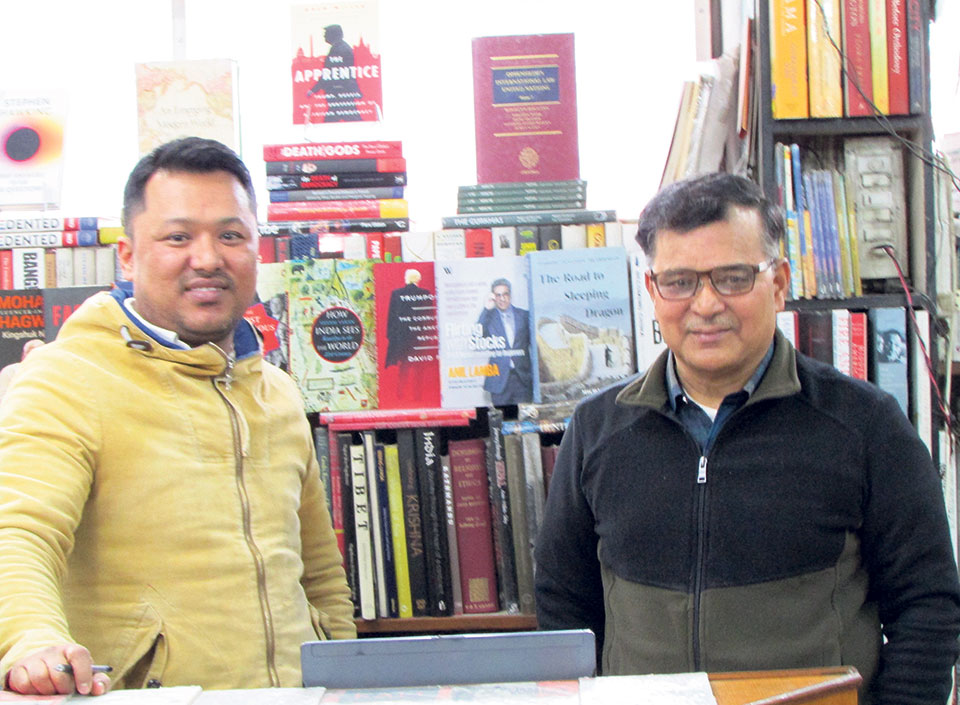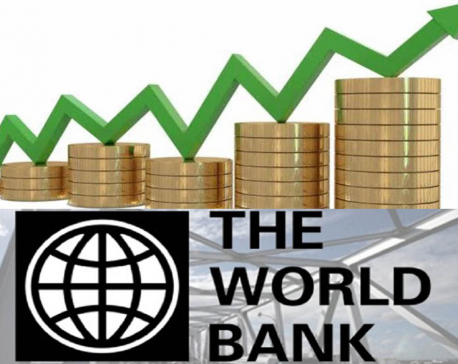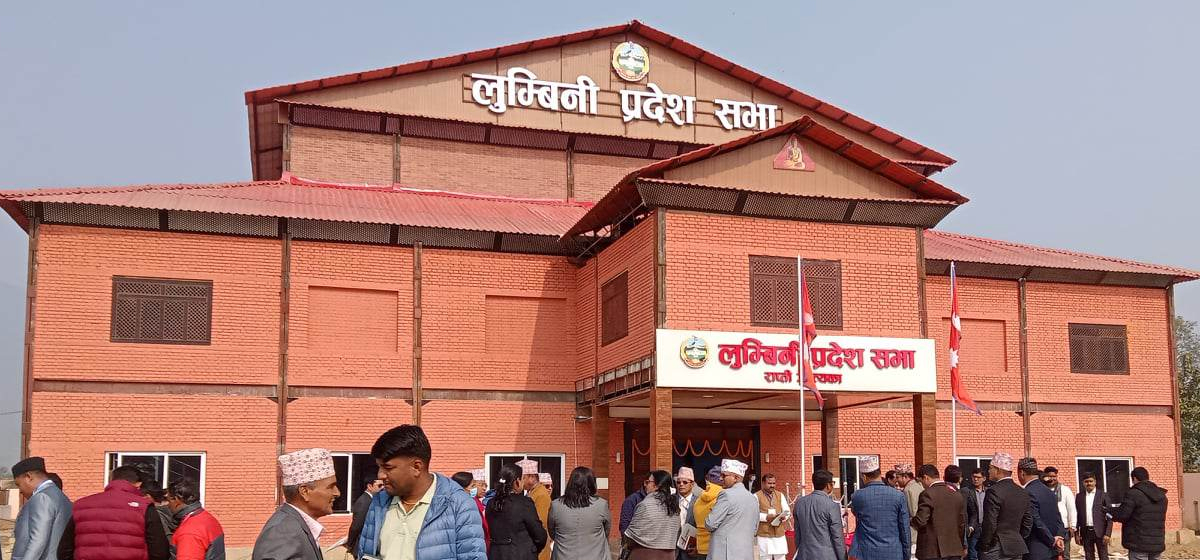
OR
Bookstores in Nepal: The past, the present and the future
Published On: February 8, 2019 08:37 AM NPT By: PAWAN KHANAL

KATHMANDU, Feb 8: Right in the heart of the bustling Kathmandu lies a sanctuary of sorts for a very rare breed of people: Mandala Book Point. In one recent afternoon, at his beloved book store, Madhav Lal Maharjan sits comfortably among the towering stacks of books in the storage room – the very place he sat when he started Mandala Book Store 29 years ago in 1988.
“A lot has changed since I started, with technology, with people and the world. Everything changes,” he shared. His store and its book collection are no exception.
Buffeted by a massive spike in demand for books and the growing reading culture, it is safe to say, at least for now, that the store has had worse days.
Over the last few years, the readership habit, especially among young crowds, has widened. The rise that has been fueled by media houses that give books the much-needed platform, a craze for Nepali writers, and an aware audience base that thrives to stay updated about the contemporaries of societies and beyond has brought book store operators like Maharjan.
However, the growth in readership has not necessarily translated into a staggering growth in book sales in the last few years. A humble man with a pinch of humor, Maharjan explains about the days back when business was running low and people coming through the door was as “rare as an honest civil servant in Nepal.”
Maharjan, now in his mid-sixties, remembers the Panchayat period where there was a limited genre of books in the market. The bookstore businesses across the nation broke its glass ceiling when people revolted against the partyless Panchayat regime in the early 1990s and democracy prevailed. “The books sharing radical ideas started pouring in the market and group of enthusiastic readers wanted any book that they could get their hands on,” he said.
Even though the reading culture was growing at a sound pace, majority of the customers coming in through the door were still foreigners. Demand for pictorial books and maps were still a major part of the bookstore businesses until the Maoist insurgency which led to a sharp decline in numbers of tourist coming into the country.
Fortunately, the demand for books from Nepali readers was, at the time, capable enough of sustaining the bookstore business. The customer base changed from foreigners to Nepali people during the time of insurgency.
“It was at that time that people yearned for more Nepali books and Nepali writers,” said Maharjan.
And the industry responded to the people’s desire.
“The scene for Nepali writers exploded with Narayan Wagle’s Palpasa Café, which was published in 2005, and has never looked back,” said Maharjan.
Palpasa Cafe, an anti-war novel, sold a record 25,000 copies in its first year. It has sold well over 100,000 copies, according Saijan Maskey, manager of Publication Nepa-laya, publisher of the novel.
Other books that were a huge hit among Nepali audience were ‘Khushi’ and ‘Seto Dharti’, among others, according to bookstore operators.
“India has also played a huge role in developing the market of bookstores in Nepal. For the past five decades, the mechanisms set in place by India to create pathways for books to come into the Nepali market has helped the industry survive hard times of the past and continues to do so as books coming in for India are comparatively cheaper than ones imported from other countries,” added Maharjan.
According to Maharjan, the ever-rising demand for books in the country after the restoration of democracy has been met by the mechanism set during the inception of books market in Nepal.
“At present, the operations cost associated with bookstore are mainly cost for rent, storage, and books that amount for more than 50 percent of the total revenue,” said Maharjan. Transportation cost and staff’s salary are the other components of the operations cost, he said, adding: “The total cost for the business is somewhere around 859-90 percent of the total revenue.”
Bookstores are doing well. But recent data published by the Nepal Rastra Bank (NRB) hits dark days loom ahead for bookstore operators. The data shows import of books dropped to Rs 1,431.5 million in Fiscal Year 2017/18, compared to Rs 1,708.5 million a year earlier – a drop of 42.5 percent.
This could imply at a lot of things: domestic publishing houses gaining a larger share of the book market, an increasing trend among people to import books from the grey market or even a shift of readers from fine print books to e-books.
“Fine print market is stagnating as technology’s influence on people has increased and the grey market is becoming increasingly popular among consumers,” said Maskey of Publication Nepa-laya.
This trend has been a hindrance to bookstore business in Nepal. It is also affecting the Nepali fine print market which expanded rapidly over the past 10-15 years.
The coming days for bookstores could be like the days during the Panchayat era when only books in the national curriculum were in demand. Piracy is another thing to worry about. The scene could take an even worse turn if technology catches up with the education systems – something that is bound to happen in the future.
However, Lokesh Dangol, sales manager of Vajra Books, says the book market, especially the market for academic books, is growing. Vajra Books, which used to publish about six academic books a year until few years back, is now publishing about twelve books a year – once every month.
He agrees that e-books and online bookstores are the future challenges for the bookstores, but adds that incorporating these services within the business model will help the market survive in the long run.
Another important factor to consider is the rising literacy rate. According to the census of 2011, the literacy rate of Nepal was at 65.9 percent which has increased by the year. “The increase in literacy rate means widening readership base,” Ajit Baral, co-founder of Fine Print Publications, said. He argued that the industry will continue to rise as the literacy rate increases.
Many people in the business shared a common view that the niche market – the core audience that prefers fine print books – will not go for e-books.
Baral said that the e-books may somehow complement the sales for fine print books as has been seen in the international market. “The trend of buying e-books is slowly reversing, and the sales of physical copies are rising in the international market as Kindle and other platforms that gave access to the e-books are losing their novelty status,” he shared. Baral, however, agrees that the younger generation, who are brought up acquainted with technology, might go for e-books.
Mandala Book Point employs 10 people. Most of them are members from extended family, and they are looking toward contributing to the future growth of readership community.
Maharjan hopes to establish Mandala as a meeting point for scholars, and people looking to get into the readership community. He plans to create a space where technology, coffee, books, and idea can freely intermingle.
The idea, by design, is ambitious and the effects will be breathtaking in scope, and can possibly have a significant role in stopping the stagnation of fine print book market if done in the right way – where bookstore and the digital e-books businesses to find a common ground to co-exist.
Radical ideas like the ones of Dangol and Maharjan are necessary to revolutionize bookstores. Bookstore operators and owners across the country should take the threat of e-books and online retailers seriously as they are slowly getting the necessary traction piggybacking on 16 million plus people who are connected to the Internet in Nepal.
You May Like This

UML leader Basnet to Balen: Don't be pampered just because you have a few hundred fans on Facebook
KATHMANDU, August 26: While the Mayor of Kathmandu Metropolitan City (KMC), Balendra Shah, is speeding up the work to demolish... Read More...

Mysterious disease killing dogs in Norway
HELSINKI, Sept 8: Norwegian authorities haven’t been able to detect the cause behind an unexplained disease that is estimated to... Read More...

Complete education, full health could double Nepal's GDP per capita: WB
KATHMANDU, June 7: Nepal has the potential to double its Gross Domestic Product (GDP) per capita in the long run if... Read More...



Just In
- Rautahat traders call for extended night market hours amid summer heat
- Resignation of JSP minister rejected in Lumbini province
- Russia warns NATO nuclear facilities in Poland could become military target
- 16th Five Year Plan: Govt unveils 40 goals for prosperity (with full list)
- SC hearing on fake Bhutanese refugees case involving ex-deputy PM Rayamajhi today
- Clash erupts between police and agitating locals in Dhanusha, nine tear gas shells fired
- Abducted Mishra rescued after eight hours, six arrested
- Forest fire destroys 13 houses in Khotang















Leave A Comment